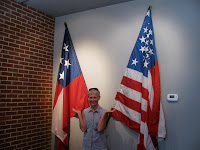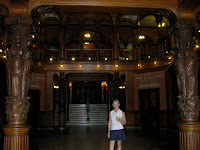
The Blue Ridge Parkway often called "America's Favourite Drive' is deserving of this label. The 469 miles commenced for us in the Great Smokey Mountains, North Carolina and moved north to the Shenandoah National Park in the Appalachians, Virginia.
Our scenic drive which joined the two parks took us through mountains, valleys, meadows and more mountains. We got a sense of the life of mountain people in this area of the United States. The views were breathless at times and thankfully there were lots of pull-offs to stop and enjoy the landscape below us.
Construction began in 1935, and the final leg was finally completed in 1987 with the spectacular Linn Cove Viaduct which looks as though it's suspended from Grandfather Mountain. This September 11th marks the 75th anniversary of the Parkway. We can thank the initiative of President Franklin D. Roosevelt for this wonderful drive. His intent was to give travellers a scenic drive and use the labour of CCC (Civilian Conservation Corps) during the Depression of the 1930's. Our drive was slow with the speed limit being 45 mph and sometimes it was difficult to even achieve that.
There were so many highlights of our week long drive that I will mention but a few. The Parkway had several Craft Centres and we visited two. The first was the Folk Art Centre near Asheville, NC operated by the Southern Highland Craft Guild and has been in operation for the past 60 years. The handicrafts of the region were well represented. The second was the Parkway Craft Centre part of Moses H. Cone Memorial Park. This stood out for us not only because of the quality workmanship but the beautiful grounds of the Park.
We continued on to the Mast General Store in Valle Crucis, NC. This store established in 1883 is still in operation and some of the items looked as though they were there since the beginning. There were barrels of candy selling for a penny. The store's motto was that it sold everything from "cradles to coffins" and after a short visit we believed it except for the fact that we had actually gone to buy a loaf of bread and couldn't find one.

The Mabry Mill, the most famous attraction on the Parkway, was well worth a stop. As well as the working of the Mill we saw an example of an Applachian home and a real whiskey still tucked in the woods. This spot brought us back the next morning for breakfast. Buckwheat flour ground at the Mill made very delicious pancakes as well as the sweet potato and cornmeal pancakes too. It was our opportunity to try famous Country Ham and biscuits. The ham was not a big hit. With full bellies we moved on and thankful that there were stops along the way to hike and work off the calories. Two of our favourite hikes were Fisher Peak Loop and Sharp Top Trail which gave us a panoramic view of the Peaks of Otter area.

Monticello or "little mountain"; home of Thomas Jefferson was one of the best tours we took on our trip. We commenced our tour with Susan our guide in Monticello Hall where visitors waited to speak with President Jefferson. The room was filled with artifacts including giftsbrought back by Lewis and Clark from their expeditions. One of the most amazing facts we learned was that the house was designed by President Jefferson and it incorporated open-air living spaces, skylights, terraces and cooking/storage spaces in the basement. It is said to be his "essay in architecture". Walking through the home gave us a clear understanding of this man's intellect. Thomas Jefferson, the third President of the United States and author of the Declaration of Independence held many talents. He was fluent in many languages, possessed thousands of books, was a self taught architecture, a pioneer in agriculture and travelledoverseas to Europe on several occasions. As well as our tour of the home we toured Mulberry Row and got a true sense of the life of a slave. Jefferson himself was conflicted by the idea of slavery his whole life. After visiting Monticello we more fully understood the ideas of "life, liberty and pursuit of happiness" and "that all men are created equal" that established the foundations of self government and individual freedom in America.
Before leaving the Monticello area we stopped for lunch at Michie Tavern. This historic tavern gave us the opportunity to sample fried chicken, pulled barbecue pork, stewed tomatoes, black eyed peas, cornbread and biscuits in a cafeteria style tavern. We did not eat another meal for the rest of the day. The site also contained a General Store, and museum shops of artisan works.
Our most exciting adventure in the Charlottesville area came when we decided to take a tour of the University of Virginia. After passing the Rotunda we continued and very quickly came upon an overpass that had a 10 foot clearance. Moho needed 11 feet. Keeping in mind that we were travelling on a narrow street with cars parked on both sides Don came to an abrupt stop. Faced with the fact that we had to make a quick decision all my thoughts diverted to the crazy motorhome movies of Chevy Chase and Robin Williams and how I now found myself in one of their crazy scenarios. There was no alternative but to back up several feet and attempt a U-turn. Charlene made her debut as the newest Charlottesville policewoman; waving and directing traffic. After several minutes we cleared what felt like a disaster and got back on the Interstate for our campground. Later that evening we laughed and pledged to write that episode in our memories.

After all the excitement of Monticello and Charlottesville it was time for relaxation. We found the perfect spot. Humpback Rocks Mountain Farm Exhibit presented an outdoor concert of bluegrass music. After feeling cheated because the Blue Ridge Music Centre was closed when we travelled through, the local band; Loose Gravel gave us the music we searched for. Humpback Rocks was ideal. We sat under a big walnut tree with the local mountain people and with the warm afternoon breezes we listened. It was very relaxing to listen to the banjo, violin and mandolin, watch the volunteers re-enact life in previous generations and generally soak up the ambiance.

So our wheels keep moving but we will not forget the picturesque lookoffs, the tunnels, the wild azaleas, the clean mountain air and the people of the Blue Ridge Parkway.































